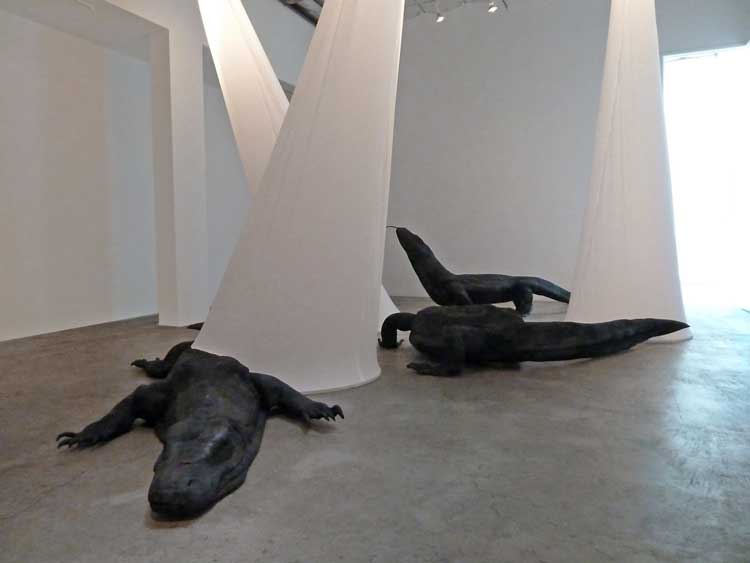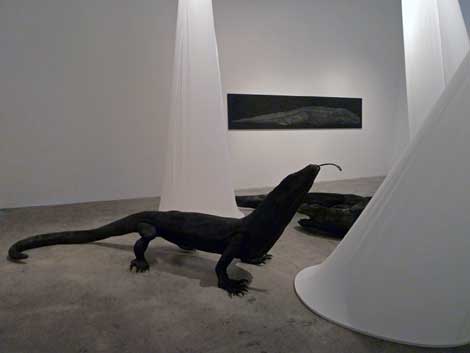As I meandered through Marisol Rendón’s installation, “So, Dragons Do Exist?” at Luis De Jesus Los Angeles gallery last summer (this was before I had even glanced at the contrarian, almost self-negating parenthetical subtitle, “Considerations of the Unavoidable Syndrome of Illusion”), I felt as if I were confronting the Kübler-Ross stages of grief acted out by Komodo dragons (all five of them, if you counted the drawings on the walls). The attitudes of the giant lizards seemed to almost anthropomorphically mimic human denial, anger, and depression or acceptance. (If you imagined a certain aggressive reptilian cunning, you might even include “bargaining” in the mix.) Instead of being directly spotlit under the tracklights, the expressively carved or molded lizards slithered around floor-to-ceiling cones of fabric wrapped around the lights like oversized lampshades. The subtly pleated fabric pooled at the floor, as if to amplify and exaggerate the weakened beam of light. One lizard, tongue extended in a hiss, seemed to bay at the light beam, while another curled itself into an angry snarl; another seemed prostrate in defeat and resignation. The densely detailed drawings were reminiscent of 19th-century natural history specimen renderings. On another wall, what from a distance looked incongruously like a study of the moon was in fact a bejeweled orb vaguely suggesting a prototype for a golf tournament trophy or the satellite from the 1971 United Artists Bond movie, Diamonds Are Forever.
I kept circling round those veiled lights—right alongside the dragons. The simple ambiguity of those shapes, that “pooled” light—suggestive of “heavenly” shafts from empyrean heights—was both fascinating and slightly deflating. I was also fascinated by Rendón’s academic credentials. In addition to her studies in sculpture and installation art, she had a degree in semiotics and hermeneutics, which already seems to tempt fate in its ambition. The ambivalence and ambiguity of the installation were clearly rooted in Rendón’s own attitudes and experience. “We do that a lot in life—throw a beautiful veil over your condition; imagining a curtain over a window; a veiled reality.”
Rendón has a fascination with illusion—both the conditions of its fabrication, and its concrete actuality, its literal fabric. Coming from a culturally and economically deprived area of Colombia (Manizales), Rendón understands the universal craving for it. “There’s a tendency to compensate for that in a very idealistic way, because of our need to always believe in something greater… We always want to have these perfect images of everything; and when you look at the real thing, it’s never like that. I don’t see illusion as something positive.”
“As a 4-year-old girl, I dreamed of castles and dragons. Then I went to the zoo to see a real Komodo dragon; and of course it’s just a big lizard. You’re disappointed; you’re killing the magic.” But Rendón adds, “understanding that disappointment is not a negative thing.” For Rendón, it’s simply the next point of departure–a point of reconnection with reality or the world of ideas. “Disappointment is just another aesthetic label—not a negative.”
Her dark drawings addressed a similarly polarity—or rather “bipolar psychological condition [of illusion].” The faceted “jewels” (which might be otherwise rendered as craters) merely emphasized the flat black void around the “lunar” sphere. “The jewels will only shine if you point the light to them.”
They also addressed superstition, the kind of “magical thinking” common to the coffee-growing region of Colombia where she grew up, and still lingering in local custom, even infecting the thinking of her own family members. “I was shocked they still lived with the idea that the next day is going to be different… But it’s something they can’t control. My own mom keeps looking for special numbers, flowers… Illusion is a kind of fake think. Hope is extremely vague to me as a concept; I don’t even like to talk about it. I want things and I go for them, but I don’t hope for them.”
In recent years, Rendón’s work has utilized representations of foodstuffs and appliances—large sculptural installations vaguely reminiscent of Claes Oldenberg—as well as such household ‘shrines’ as the refrigerator and (still more recently) the kitchen sink, as loci of similar human hopes and aspirations. Rendón sharply differentiates her work from Oldenberg’s more “playful, sexual” productions, but feels that it’s only a matter of time before other tools and appliances—the laptop, the smart phone—are similarly ‘enshrined’. “Every day we’re using these extensions of our bodies, mutating into all these things, in both positive and negative ways. They become extensions of who we are. More and more I believe we’re replacing ourselves through these objects.”
I wanted to say to her, “I hope not,” but I didn’t dare.



